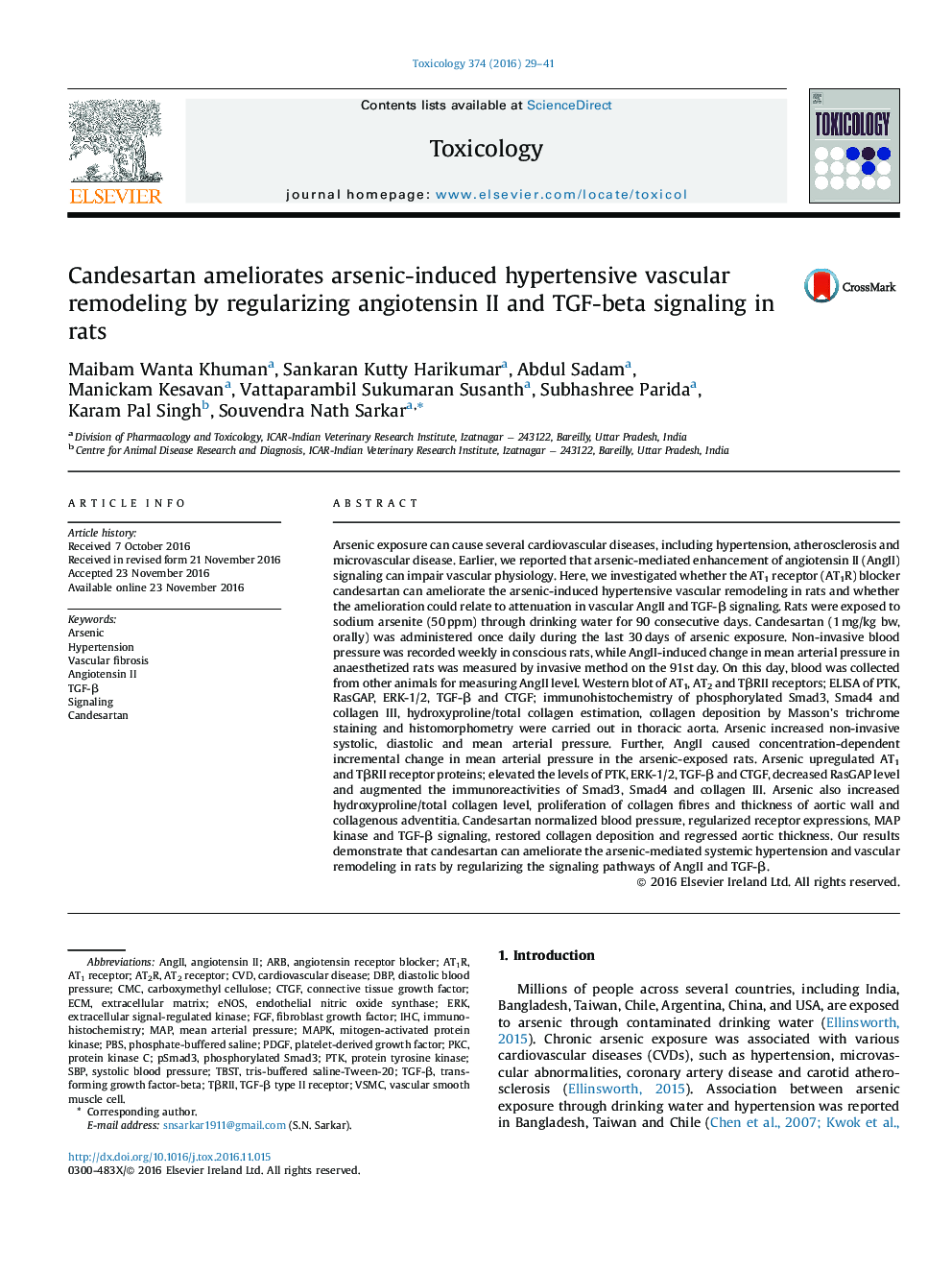| Article ID | Journal | Published Year | Pages | File Type |
|---|---|---|---|---|
| 5561882 | Toxicology | 2016 | 13 Pages |
Abstract
Arsenic exposure can cause several cardiovascular diseases, including hypertension, atherosclerosis and microvascular disease. Earlier, we reported that arsenic-mediated enhancement of angiotensin II (AngII) signaling can impair vascular physiology. Here, we investigated whether the AT1 receptor (AT1R) blocker candesartan can ameliorate the arsenic-induced hypertensive vascular remodeling in rats and whether the amelioration could relate to attenuation in vascular AngII and TGF-β signaling. Rats were exposed to sodium arsenite (50 ppm) through drinking water for 90 consecutive days. Candesartan (1 mg/kg bw, orally) was administered once daily during the last 30 days of arsenic exposure. Non-invasive blood pressure was recorded weekly in conscious rats, while AngII-induced change in mean arterial pressure in anaesthetized rats was measured by invasive method on the 91st day. On this day, blood was collected from other animals for measuring AngII level. Western blot of AT1, AT2 and TβRII receptors; ELISA of PTK, RasGAP, ERK-1/2, TGF-β and CTGF; immunohistochemistry of phosphorylated Smad3, Smad4 and collagen III, hydroxyproline/total collagen estimation, collagen deposition by Masson's trichrome staining and histomorphometry were carried out in thoracic aorta. Arsenic increased non-invasive systolic, diastolic and mean arterial pressure. Further, AngII caused concentration-dependent incremental change in mean arterial pressure in the arsenic-exposed rats. Arsenic upregulated AT1 and TβRII receptor proteins; elevated the levels of PTK, ERK-1/2, TGF-β and CTGF, decreased RasGAP level and augmented the immunoreactivities of Smad3, Smad4 and collagen III. Arsenic also increased hydroxyproline/total collagen level, proliferation of collagen fibres and thickness of aortic wall and collagenous adventitia. Candesartan normalized blood pressure, regularized receptor expressions, MAP kinase and TGF-β signaling, restored collagen deposition and regressed aortic thickness. Our results demonstrate that candesartan can ameliorate the arsenic-mediated systemic hypertension and vascular remodeling in rats by regularizing the signaling pathways of AngII and TGF-β.
Keywords
CTGFANGIIAT1RTBSTPKCPDGFAT2RARBeNOSERKFGFECMPBSSBPPTKCMCDBPMAPKAngiotensin IIImmunohistochemistryIHCcardiovascular diseaseCVDendothelial nitric oxide synthaseConnective tissue growth factorplatelet-derived growth factorfibroblast growth factordiastolic blood pressuresystolic blood pressuremean arterial pressureExtracellular matrixPhosphate-buffered salineAngiotensin receptor blockermapProtein tyrosine kinaseProtein kinase Cmitogen-activated protein kinaseCarboxymethyl celluloseextracellular signal-regulated kinaseAT1 receptorAT2 receptor
Related Topics
Life Sciences
Environmental Science
Health, Toxicology and Mutagenesis
Authors
Maibam Wanta Khuman, Sankaran Kutty Harikumar, Abdul Sadam, Manickam Kesavan, Vattaparambil Sukumaran Susanth, Subhashree Parida, Karam Pal Singh, Souvendra Nath Sarkar,
